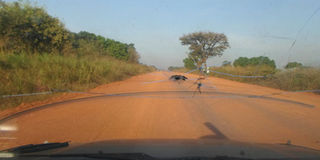Rickety ride on a bumpy road

A view of part of the dusty road from Gulu to Kitgum. Photo by Roland Nasasira
What you need to know:
THE TRIP THAT WAS. From Gulu to Kitgum, I boarded and estate wagon which ended up overloaded with people and luggage, writes, Roland D. Nasasira.
A few days ago when I travelled from Kampala to Gulu Town, the 332 kilometre- journey by an all tarmac road felt smooth. It took us approximately six hours.
Due to the language barrier, I could not chat to anyone. I dozed off aboard the Homeland coach. When I finally reached Gulu Town, I stretched out as I went to the field. I spent there almost two hours. My next stop would be Kitgum District.
Off to Kitgum
It is approximately 100 kilometres from Gulu Town. After sufficient consultations, I was advised to go to Gulu Taxi Park. Luckily, the motorcyclist who took me to the park dropped me off at the park exit where I found a Kitgum-bound vehicle awaiting.
To my surprise, one of the touts ushered me into a black Toyota Carib 1992 model with UAG number plate series. When I asked around before I could pay the Shs13,000 fare, I was told that was the best vehicle plying that route. On peeping inside the vehicle, I asked the tout about which seat I had to occupy. There were five passengers.
“My brother, I now need about four more passengers to set off,” the tout replied, adding, “Since you seem new in Gulu, I will create space for you on the co-driver’s seat.”
Inside the vehicle
I was assured of using the co-driver’s seat alone. But the tout was quick to say that I had to share it with another passenger. In between the driver and co-driver’s seat, a cushion was placed for me to brave a two-hour journey.
I sat legs apart; the right leg to the driver’s side and the left on the co-driver’s, with a gear lever between my legs and a breast feeding mother to my left.
For a passenger to alight, the driver would ask me to widen my legs for him to park the crickety vehicle and narrow them to engage the driving mode. That is not all. Clouds of dust snaked through the door openings and from underneath. Covering my nose with a handkerchief was not optional.
The baby started coughing. When I asked the driver to do something for the baby’s sake, he told me the car windows were defunct. When I looked at his door and saw no switch boards, I confirmed we were “in a dangerous mechanical condition”.
Passengers
On making the first stop, when I looked behind, the passenger seat had four people and a tarpaulin laid in the boot, also with four more people. They were casually chatting away in their local dialect.
For a vehicle that is meant to carry four to five passengers, it had been mercilessly loaded with 10, excluding the driver. As we went on with the journey, I not only realised that there were no traffic stops, which perhaps explained why vehicles, apart from buses that ply the Gulu - Kitgum road were overloaded.
When we alighted, the rack too had bundles of luggage. What if the roof had caved in?




